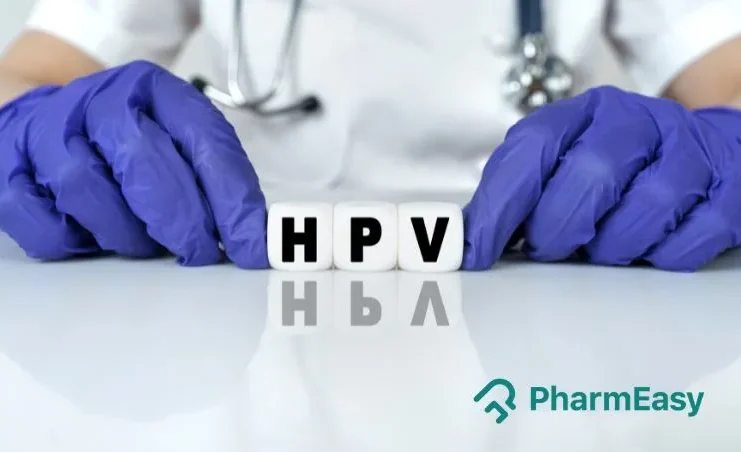How HPV Can Lead to Cancers
By Dr. Vishesh Bharucha +2 more

Get,

to manage your symptom
Get your,


4 Cr+ families
benefitted

OTP sent to 9988776655



You’ve successfully subscribed to receive
doctor-approved tips on
Whatsapp

Get ready to feel your best.

Hi There,
Download the PharmEasy App now!!


Register to Avail the Offer
Send OTPBy continuing, you agree with our Privacy Policy and Terms and Conditions

Hi There,
Sign up on PharmEasy now!!
Trusted by 4 crore+ families

OTP sent to 9988776655



You have unlocked 25% off on medicines




Code: NU25
By Dr. Vishesh Bharucha +2 more
Table of Contents
Human Papillomavirus (HPV) is the most common sexually transmitted infection (STI) worldwide, with nearly 80% of the global population exposed by the age of 501. While the immune system clears most HPV infections (within 1 to 2 years), persistent infection can be hazardous to health2,3.
There are over 200 known subtypes of HPV that are broadly categorised into low-risk and high-risk types, with around 40 subtypes affecting the genital tract2,4. Low-risk types, such as HPV 6 and 11, typically cause benign (non-cancerous) conditions like genital warts. In contrast, persistent infection with high-risk types (most notably HPV 16 and 18) can lead to precancerous lesions and malignancies. High-risk HPV types are associated with various cancers, including cervical, anal, oropharyngeal (back of the throat), and penile cancers3.

Vaccines are available and effective in preventing infection with the most common low and high-risk HPV types. However, global vaccination coverage still remains suboptimal1,3. Therefore, understanding the link between persistent HPV infection and cancer is critical for prevention, early detection, and treatment strategies.
HPV is mainly spread through skin-to-skin contact, especially during sexual activity. Here’s how transmission can happen:
Most people infected with HPV may not experience any symptoms. They may not even be aware that they have the virus. When symptoms do appear, they depend on the type of HPV involved. Common signs and symptoms include:
HPV can cause cancer when high-risk types of the virus stay in the body for a long time and interfere with how normal cells grow and divide.
In the early stages of an HPV infection, the virus multiplies in the skin or mucosal cells without immediately causing harm. Over time, when high-risk HPV types insert their genetic material into the human DNA, it leads to the constant production of oncoproteins. These are proteins produced by the virus that promote cancer growth by interfering with the growth and division of normal cells, which can eventually lead to abnormal or precancerous changes, and, if not treated, possibly cancer.
These proteins produced by the virus disrupt the functioning of tumour-suppressor proteins, which are proteins present in the body cells that help with DNA repair, control the cell cycle, and prevent uncontrolled cell growth. The oncoproteins produced by HPV in the body are3:
The inactivation of tumour-suppressor proteins p53 and pRb leads to impaired DNA repair mechanisms and loss of cell cycle control, creating conditions that cause uncontrolled cell growth and eventually cancer development.
Note: It’s important to note that wart-like lesions are usually caused by low-risk HPV types and do not typically progress to cancer. In contrast, high-risk HPV types can cause abnormal cell changes (like cervical intraepithelial neoplasia or CIN), which may become cancerous if not detected and treated early3.
Did you know that HPV is estimated to cause around 690,000 cancers worldwide each year6?
Let us take a look at the types of cancers that are linked to HPV:
HPV and cervical cancer are very closely linked. This is because almost all cervical cancer cases are caused by HPV6.
More than 90% of anal cancer cases are caused by HPV6.
About 70% of oropharyngeal cancers, which occur in the middle part of the throat behind the mouth, are linked to HPV6.
Note: People often confuse oropharyngeal cancer with mouth and throat cancer, but they are not the same; each affects different areas within the head and neck region.
Approximately 75% of vaginal cancer cases are linked to HPV6.
HPV is responsible for around 69% of vulvar cancer cases. This cancer affects the outer part of the female genitalia6.
Around 63% of penile cancer cases are attributed to HPV. This rare cancer usually develops on or under the foreskin of the penis6.
Different types of HPV-related cancers have different diagnostic approaches. While some have well-established screening tests, others are detected only after symptoms appear or through targeted exams in high-risk individuals.
Note: Women should begin regular cervical cancer screening at age 30, with tests typically recommended every 5 to 10 years, depending on the type of test used and individual risk factors2.
Note: In all cases, a biopsy is done to confirm the diagnosis if any abnormalities are found.
Also Read: HPV Vaccine: What is It, When to Be Taken, Importance & Side Effects
While most HPV infections go away on their own without causing symptoms, some can lead to serious health issues if left untreated. Knowing when to seek medical advice is key to early detection and prevention. You should see a doctor if you experience:
Unusual vaginal discharge or foul odour (Although these may not be specific to HPV and are commonly linked to other infections like bacterial vaginosis, still these warrant medical evaluation)2
Note: It’s important to follow regular screening schedules based on your age and risk factors to detect any HPV-related changes early.
Also Read: HPV in Men: What It Is, Causes, Symptoms & Treatment
HPV vaccination offers safe, effective, and long-lasting protection against the most cancer-causing HPV infections, especially when given before exposure. Three types of HPV vaccines have been developed, each protecting against different numbers of HPV types12,13:
Also Read: Human Papillomavirus (HPV): What Is It, Causes, Symptoms, and Prevention
Despite being a common viral infection, the majority of HPV-related cancers are preventable through regular screenings and timely vaccination. Therefore, it is important to raise awareness about HPV, its risks, and the need for early detection and vaccination in reducing the incidence of these cancers. Routine screening helps detect abnormal cell changes early, allowing for prompt treatment and improved outcomes. At the same time, HPV vaccination offers strong protection against high-risk strains, particularly when administered before exposure. These measures can help contribute to reducing the global burden of HPV as well as ensure better long-term health for individuals and communities alike.
Routine HPV vaccination, regular screening (like Pap and HPV tests), and practising safe sex are key strategies for prevention2.
The HPV vaccine is recommended for all children aged 9 to 12 years. Catch-up vaccination is available for males and females up to age 26. In some cases, vaccination may be considered up to age 453,12. Talk to your doctor if you have doubts or are unsure.
Condoms greatly reduce the risk, but do not offer 100% protection because HPV can infect areas not covered by condoms2.
No. HPV affects all genders. It can cause cancers of the penis, anus, and oropharynx in men, and genital warts in anyone. Therefore, vaccination and awareness are important for everyone2.
There is no cure for the virus itself, but most infections clear on their own. Treatments are available for symptoms (like warts) and for precancerous or cancerous lesions3.
Disclaimer: The information provided here is for educational/awareness purposes only and is not intended to be a substitute for medical treatment by a healthcare professional and should not be relied upon to diagnose or treat any medical condition. The reader should consult a registered medical practitioner to determine the appropriateness of the information and before consuming any medication. PharmEasy does not provide any guarantee or warranty (express or implied) regarding the accuracy, adequacy, completeness, legality, reliability or usefulness of the information; and disclaims any liability arising thereof.
Comments

Leave your comment...
You may also like
Comments